Muscularis externa Samenvattingen, Aantekeningen en Examens
Op zoek naar een samenvatting over Muscularis externa? Op deze pagina vind je 189 samenvattingen over Muscularis externa.
Pagina 4 van de 189 resultaten
Sorteer op

-
Chapter 9: Gastrointestinal System Martin Caon Examination Questions and Answers in Basic Anatomy and Physiology Third Edition
- Tentamen (uitwerkingen) • 38 pagina's • 2023
-
Ook in voordeelbundel
-
- €7,00
- + meer info
Martin Caon Examination Questions and Answers in Basic Anatomy and Physiology Third Edition Chapter 9: Gastrointestinal System 9.1 Anatomy and Function 1. Which type of cell produces hydrochloric acid? a. Zymogenic cells b. Parietal cells c. Chief cells d. Enteroendocrine cells Answer is B: The parietal cells of gastric glands produce hydrochloric acid. (Zymogenic cells are the same as chief cells, and they produce pepsinogen.) 2. What is the role of gastrin in the digestive ...
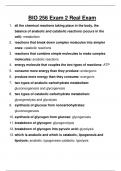
-
BIO 256 Exam 2 Real Exam 2023
- Tentamen (uitwerkingen) • 7 pagina's • 2023
-
- €10,90
- + meer info
BIO 256 EXAM 1 Real Exam 1. The salivary enzyme amylase functions to break down.: Carbohydrates 2. Peristalsis occurs in the digestive tract: from the pharynx to the anus 3. The ________________ serves as a valve that controls the movement of food between the esophagus and the stomach.: lower esophageal sphincter (also gastroesophageal or cardiac sphincter) 4. The membrane that binds the small intestines to the abdominal wall is called?: Mesentery 5. The accessory organs of the...
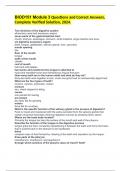
-
BIOD151 Module 3 Questions and Correct Answers, Complete Verified Solution, 2024.
- Tentamen (uitwerkingen) • 5 pagina's • 2024
-
- €10,42
- + meer info
BIOD151 Module 3 Questions and Correct Answers, Complete Verified Solution, 2024. Two divisions of the digestive system alimentary canal and accessory organs seven parts of the gastrointestinal tract mouth, pharynx, esophagus, stomach, small intestine, large intestine and anus six digestive accessory organs teeth, tongue, gallbladder, salivary glands, liver, pancreas mouth opening lips floor of the mouth tongue walls of the mouth cheeks roof of mouth hard and soft palates two bo...
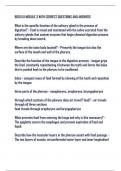
-
BIOD 151 MODULE 3 WITH CORRECT QUESTIONS AND ANSWERS
- Tentamen (uitwerkingen) • 10 pagina's • 2024
-
- €19,92
- + meer info
BIOD 151 MODULE 3 WITH CORRECT QUESTIONS AND ANSWERS What is the specific function of the salivary gland in the process of digestion? - Food is mixed and moistened with the saliva secreted from the salivary glands that contain enzymes that begin chemical digestion process by breaking down starch. Where are the taste buds located? - Primarily the tongue but also the surface of the mouth and wall of the pharynx. Describe the function of the tongue in the digestive process - tongue gri...
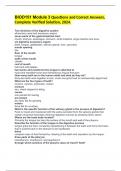
-
BIOD151 Module 3 Questions and Correct Answers, Complete Verified Solution, 2024.
- Tentamen (uitwerkingen) • 5 pagina's • 2024
-
- €10,32
- + meer info
BIOD151 Module 3 Questions and Correct Answers, Complete Verified Solution, 2024. Two divisions of the digestive system alimentary canal and accessory organs seven parts of the gastrointestinal tract mouth, pharynx, esophagus, stomach, small intestine, large intestine and anus six digestive accessory organs teeth, tongue, gallbladder, salivary glands, liver, pancreas mouth opening lips floor of the mouth tongue walls of the mouth cheeks roof of mouth hard and soft palates two bo...
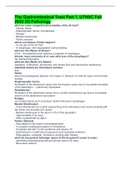
-
The Gastrointestinal Tract Part 1, UTHSC Fall 2022 D2 Pathology (Answered)
- Tentamen (uitwerkingen) • 7 pagina's • 2023
-
- €10,62
- + meer info
The Gastrointestinal Tract Part 1, UTHSC Fall 2022 D2 Pathology what are some congenital abnormalities of the GI tract? - Atresia, fistula - Diaphragmatic hernia, omphalocele - Ectopia - Meckel diverticulum - Pyloric stenosis where can Atresia, Fistula happen? - In any part of the GI tract - In esophagus, with regurgitation during feeding what are the effects of atresia? a thin , noncanalized cord replaces a segment of esophagus Atresia, most commonly at or near what area of the esop...
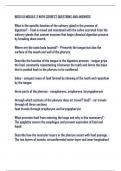
-
BIOD 151 MODULE 3 WITH CORRECT QUESTIONS AND ANSWERS
- Tentamen (uitwerkingen) • 10 pagina's • 2024
-
- €19,82
- + meer info
BIOD 151 MODULE 3 WITH CORRECT QUESTIONS AND ANSWERS What is the specific function of the salivary gland in the process of digestion? - Food is mixed and moistened with the saliva secreted from the salivary glands that contain enzymes that begin chemical digestion process by breaking down starch. Where are the taste buds located? - Primarily the tongue but also the surface of the mouth and wall of the pharynx. Describe the function of the tongue in the digestive process - tongue gri...
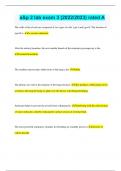
-
a&p 2 lab exam 3 (2022/2023) rated A
- Tentamen (uitwerkingen) • 8 pagina's • 2023
-
Ook in voordeelbundel
-
- €9,48
- + meer info
a&p 2 lab exam 3 (2022/2023) rated A The walls of the alveoli are composed of two types of cells, type I and type II. The function of type II is: to secrete surfactant. After the tertiary bronchus, the next smaller branch of the respiratory passageway is the: terminal bronchiole. The smallest macroscopic subdivision of the lung is the: lobule. The pleurae are vital to the integrity of the lungs because: they produce a lubricating serous secretion, allowing the lungs to glide over the thorax ...
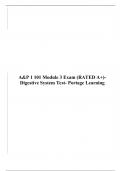
-
A&P 1 101 Module 3 Exam (RATED A+)-Digestive System Test- Portage Learning
- Tentamen (uitwerkingen) • 14 pagina's • 2023
-
Ook in voordeelbundel
-
- €12,34
- + meer info
A&P 1 101 Module 3 Exam-Digestive System Test Question 1 5 / 5 pts Explain why a patient with liver disease would have intolerance to fatty foods. Your Answer: Because one of the function of t he liver is to produce bile. Bile is used to emulsify fat, if the fat cannot be broken down, the patient will have intolerance with fatty foods. The liver produces bile which breaks down fats. If it is not producing bile (or less bile), fats will not be broken down effectively. Question 2 5 / 5 pts Explain...
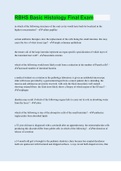
-
RBHS Basic Histology Final Exam | 60 Questions with 100% Correct Answers | Updated & Verified
- Tentamen (uitwerkingen) • 8 pagina's • 2022
-
- €8,06
- + meer info
in which of the following structures of the oral cavity would taste buds be localized in the highest concentration? - vallate papillae certain antibiotic therapies slow the replacement of the cells lining the small intestine. this may cause the loss of what tissue type? - simple columnar epithelium the tenure coli of the large intestine represent an organ specific specialization of which layer of the intestinal tract wall? - muscularis externa which of the following would most likely resul...



